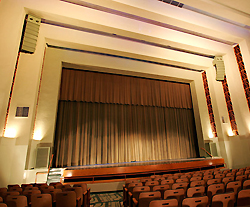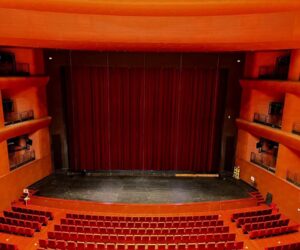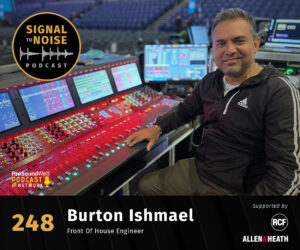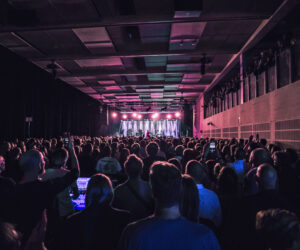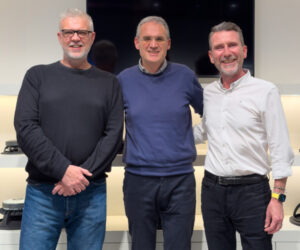Barnum Hall, a beautiful Art Deco-style performance hall built in the late 1930s on the campus of Santa Monica High School, recently underwent an extensive restoration that has rejuvenated the 25,980 square-foot structure, including a new sound system featuring QSC Audio components that were implemented with sensitive awareness to maintaining the historic nature of the architectural design.
“Initially the project went to bid on what was described as a very strict budget,” recalls Joe Byrne from the North Hollywood, California offices of Pro Sound. “Because of the budget limitations, I specified an analog system with a central cluster.”
One of two parties vying for the contract, Byrne and Pro Sound ultimately came in slightly under-budget, while the competitor went considerably over. Considering the difference between the two and what was provided by each, the client came back and asked Pro Sound to rebid the job, this time with a larger purse to work with.
“The budget did indeed grow the second time around,” Byrne relates. “But the client was asking for significantly more in return. They wanted the system to be stereo, a digital console, and a communications system to facilitate production needs. It was a showcase room, and the sound system had to reflect that same character, all while remaining unobtrusive within the environment.”
An inspiring setting built for both students and the community at large, Barnum Hall plays host to concerts, plays, musicals, and more. Bound by a budget that was indeed larger, but now had to perform with greater vigor on a number of levels, Byrne once again sharpened his pencil and set about creating another design.
While a line array seemed logical for the space, it wasn’t until Byrne’s discovery of QSC’s ILA (Installation Line Array) components that such technology became economically viable.
“When we were in the second design phase of the Barnum Hall project, most line array systems were built for touring applications,” Byrne explains. “Touring systems have to be extra rugged, and require expensive suspension hardware. As a result, the price of most line arrays was out of reach of a budget like we had at Barnum Hall.
“QSC’s ILA system, however, uses molded enclosures and a simplified rigging design built for installation applications. ILA brought the cost down and made the technology much more accessible, all while retaining the sound quality, coverage and power of a touring system.”
As utilized in Barnum Hall, seven full-range, WL2082-i ILA Series enclosures are flown left and right of the proscenium, atop which resides a single WL115-sw subwoofer on each side. Using QSC power including a PowerLight 4.0 and CX1102 and CX702 amplifiers, the stereo arrays are tri-amped and operate in conjunction with QSC BASIS 904zz processing.
“We considered self-powered loudspeakers for the hall, but the inherent problem with going that route is that you have to bring power to all the loudspeakers,” Byrne says, providing more backstory on the build. “That simply wasn’t cost-effective here. “By choosing ILA, we were able to work with one single supplier for all of our needs right from the output of the console to the loudspeakers. Everything is linked via dataports as well, a fact which allows us to maintain, troubleshoot, and make system changes remotely if we want to, plus create security features to prevent unauthorized tampering.”
In keeping with the client’s request, a Yamaha M7CL console was installed at the front of house mix position. Using CX302 and CX902 amplifiers, under-balcony sound reinforcement is managed by another pair of WL2082-i ILA Series cabinets. A pair of groundstacked QSCMD-S218 ModularDesign Series subwoofers also chosen from the QSC catalog complements the entire system with added low frequency response. Processing for both the under balcony enclosures and the MD subs is managed by a second BASIS unit, this time a model 902zz.
Using a microphone placed in various areas around the room, Smaart was used to test phase cancellation, intelligibility, overall EQ, and to set delay times for the underbalcony cabinets. Byrne also gives engineering credit to QSC’s Shawn Watts and Scott Kalarchik for their assistance with EASE modeling and BASIS programming, and readily admits he’d be totally remiss if he failed to thank his right-hand man on the job, Chris Anderson.
“There were only two of us doing the actual install,” he notes. “With the compact and lightweight ILA cabinets and dataport input and outputs, it was really easy to hook everything up once the wiring infrastructure was in place. Once we were finished, the client was really happy with the aesthetics and overall sound.
“Even with the additional money, I had to cut out some wireless mics and other items to stay within the budget, but bottom-line, they got the performance they wanted, a nice selection of hardwired mics, professional Whirlwind snake system with a transformer-isolated split onstage, and everything is digital. This was the time and definitely the place where we were able to do more with less.”


